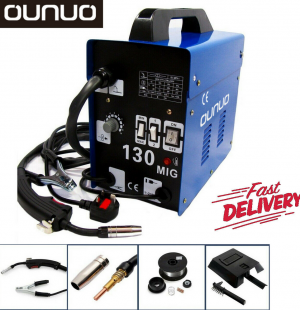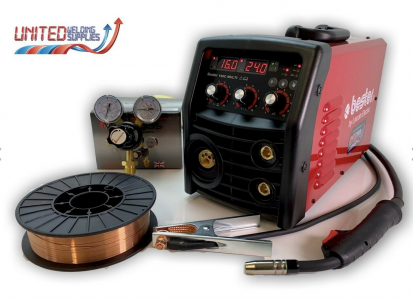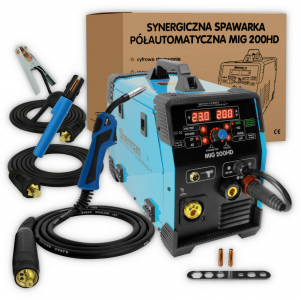I am generally loathe to offer a budget selection. Most of the "welder evaluation websites" suggestions are horribly tainted (either through sponsorship by a specific vendor/vendors, or in the worst cases, are pretend evaluation sites put up by a manufacturer.
If I read your parameters correctly, you are wanting to stay under 800 Pounds of cost. This particular welder is mentioned on several sites and spoken about with generally favorable terms. It supports MIG, TIG, Stick welding. It goes without saying it can run flux-core wire too. It supports an optional MIG spool gun for doing aluminum as well. It is one of the types I call "semi-smart" as it allows the user to tell it the "process" he wants to use, and sets default voltages and wire feeds it "believes" are ideal, but has a "menu" option to adjust the voltage to a more preferred choice. The machine will then adjust feed rate to what it thinks is correct. According to the reviewers, the semi-smart machine's best guess are good starting points for novice welders.
It comes with the TIG torch, MIG gun, and a Rod holder. It also has an unusually high quality return clamp (sometimes called a ground clamp). It includes a ball-type flow gauge in the package too. It is kitted out fairly nicely, as so many budget kits make you purchase some of these items at an additional cost.
The welder has a United States friendly feature which is of no use for you (it runs on 110 and 220). For Yanks who are not always near a 220 socket, this feature can have merit. I believe it can be purchased, and the optional spool gun for aluminum as a side purchase, for under your 800 pound price point.
I realize this link is a US seller (Amazon), however, it will give you the make/model and a general description for you to find one in your market.
Weldpro 200 MIG
Thanks so much. You have hit exactly my thoughts. Quite early on, I ended up completely done with so-called "review" sites and videos. I would trust a description of experience and recommendation posted on this site by a regular member, and I believe I can trust pretty much all of them. If one of us bought, and regretted, and posted what the shortcomings were, I would expect it would not be done frivolously.
The
£800+ welder was, for me, a perhaps a price too high for me, for what it does, as compared to several welders
below £600 that seem to offer the same capability. I was having to look deeper at extra "features", or try to perceive "sheer build quality", perhaps only known from reputation.
We can also tell that the "budget" welders
under £200 either offer with limits to functionality, constrained build quality, limited duty cycle, or other downsides. I think this is true, even if it comes from China!
New electronic technology, especially put in lower cost kit from East European countries, and China/Korea/Taiwan, can genuinely produce welders that are competitive while being lighter and lower cost, but one cannot pitch a whole lot of decision value on this. The reason is that the suppliers are generally more intent on driving the price down than using the advantage to enhance build quality. For putting a value judgement on budget welders, I have only partial statistics and hard knowledge. I have now overloaded from trawling welder advertisements, reviews, and explanations.
It's OK to go for a
sub £200 budget welder. It will do some welds for you. If you want the welder to please you for years, I thing "budget" should have a reasonable base at about £250 (think around $330 to $340), but look close. If a $330 deal includes a whole bunch of extras, try and work back to the fraction of that represents the welder that these extras are in there to help shift. You will very likely discover that it is a MIG welder that has no way to connect gas - so call it "gasless"
Here is a "budget" welder I cannot recommend..
-->
GASLESS MIG 130 from eBay UK Link
-->
GASLESS MIG 130 from eBay USA Link
The only button it pushes is the low cost.
$120 is a step so far that I think you only go here if you welds are all outside in the wind, and you don't want to use a gas bottle, and the welds you want to do are never going to need more than 130A and 1.5mm to 4mm (max). The duty cycle is 10% for a 120A weld, and 35% for a 60A weld. I am not sure how often a decent weld is 60A
I show the above for a very low cost example. At that price, one could invest in it as an additional welder purchased for a single welding job that happens to be out in the wind. At this price, there very likely will also be build quality compromises. It has a 1 year warranty.

Without it being a contest to find the cheapest offer, this one has to be right down there!
- - - - - - - - - - - - - - - - - - -
Look at Lincoln
Deliberately here, I do not yet approach the $1000 welder.
This welder is hard to search out on Amazon, but the deal is
$687.27 from eBay, with free international shipping.
It's MIG and also TIG, and also polarity reversible. 180A. If you need to use stick out in the wind, it can do it.
You do need the 220/240V supply socket.
If USA welder wannabees check with local Lincoln outlets, the deal could get better.
-->
Lincoln Bester 190C Multi-Process MIG UK eBay link. £515 free delivery
--> Lincoln Bester 190C Multi-Process MIG USA eBay link. £687.27 free international delivery

Is this the "everything" welder from a famous trusted brand, with 2 Year guarantee?
- - - - - - - - - - - - - - - - -
There are, of course, dozens of others. Feel free to check them out. The features explanations that have happened in this thread provide lots of solid information to help folk chose on welders as applied to the kinds of welds and conditions, and additional essentials that will also come with a cost. The sheer number let you know that there is lots of competition to provide for home welder aspirations.
For my choice, it is a toss-up between the excellent stuff from R-Tech recommended by
@Lo-Fi at the beginning of this thread, and the "do everything" Sherman MIG200HD.
It need not be that particular brand, but you can check off it's list of attributes, and take a glance at the price. Then, pick through Amazon, and eBay, looking for welders that "fit" that value, only because these two give you a swift look at what you can get, with real prices. Then you can look online with more specific keywords and model numbers, to find other outlets. It's better than being overwhelmed by keywording Google to look at "images" tab.
For the Sherman 200 - see posting
#61.
For the Sherman 200HD "do anything" welder - see posting
#64.

This one, for £329 (think about $439) is the one that has me most tempted. Partly from it's apparently being a full feature MIG, and TIG all in one, the price leaves room to go for the Lincoln Electric Viking auto-dark helmet.
There are also a whole bunch of impressive welders from
MILLER, and
HOBART .





